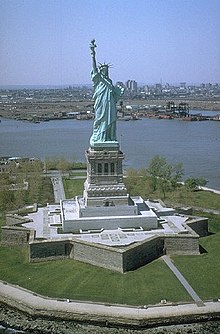|
A brief history of United States coastal defenses and the U.S. Army Coast Artillery Corps |






- By RobDuch
I've been interested in forts almost all my life. When I was eight years old we visited my grandmother frequently. She lived within walking distance of an abandoned Endicott fort. I was fascinated by it, and gradually explored its passages and magazines. I was in New England, which had several abandoned forts, many with holes in the fences. When I was a teenager my father occasionally took my brother and I on fort-finding expeditions, which we continued once I learned to drive. In the 1990s I joined the Coast Defense Study Group, which visits, compiles information on, and contributes to the preservation of US forts. I went on two of their harbor defense tours that decade, Portland, Maine and Long Island Sound, New York (including Fort Terry at the USDA animal disease research facility on Plum Island.
I began editing Wikipedia in August 2013, initially on U.S. Navy articles. In early 2015 I turned my attention to U.S. Army fort-related articles. Some important articles had been written, but in most cases they were in need of expansion, or updating to meet current standards. I began with the articles on weapons, in most cases expanding them to include variants, such as 12-inch gun M1895, to which I added the M1888 and M1900 versions of this weapon. Eventually I created new articles for the remaining U.S. coast artillery weapons. There were several fort articles, including most of the third system (built 1819–1867), but these usually had little or no information on the new Endicott batteries added circa 1900. I also worked on the main Seacoast defense in the United States article, gradually over several years. I published my first complete fort article, Fort McKinley (Maine), in September 2015. In late 2016 I decided to create overarching articles on the harbor defense commands. For better or worse, I decided to include an overview of the entire history of coastal forts in each command's area. I published the first of these, Harbor Defenses of Portland, in early 2017. I've proceeded mostly geographically along the U.S. east coast, and so far I've got to Harbor Defenses of the Delaware. Chesapeake Bay is in the works. I've preceded each of these articles with an update, creation, or expansion of each fort's article. In 2018 I decided to improve the articles on the U.S. forts in the Philippines, the only ones to see heavy combat since the American Civil War, culminating in Harbor Defenses of Manila and Subic Bays, which I took from 4kb to 47kb. These varied widely in quality and quantity of information. I relied heavily on the online version of the U.S. Army's official history volumes for both the 1941–42 and 1944–45 campaigns involving these forts.
I built up something of a reference library in the course of doing this. For U.S. Army Ground Forces unit info during World War II, Stanton's World War II Order of Battle is very good, going down to battalion level. The best single reference on U.S. forts in the 1895–1945 period is Mark Berhow's American Seacoast Defenses, A Reference Guide, Third Edition, written by members of the Coast Defense Study Group (CDSG). This includes a list of each U.S. fort and battery, an overview of weapon types, and thorough Coast Artillery Corps organization info. A good recent work on the third system forts is John Weaver II's A Legacy in Brick and Stone, Second Edition. Perhaps the only readily available comprehensive work on the first and second system forts and the circumstances surrounding their construction is Arthur P. Wade's Artillerists and Engineers. Online, the CDSG's fort and battery list is very good, with a lot of other material on the site as well. Capsule unit histories for the coast artillery regiments are in two articles by William C. Gaines, one for the regular army and one for the National Guard. A comprehensive order of battle series for the previously neglected period 1919–41 by Steven Clay is online, the second volume of which includes the coast artillery.
